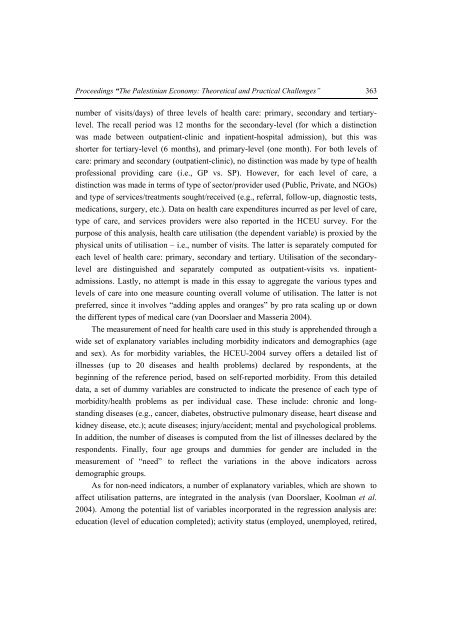The Palestinian Economy. Theoretical and Practical Challenges
The Palestinian Economy. Theoretical and Practical Challenges
The Palestinian Economy. Theoretical and Practical Challenges
You also want an ePaper? Increase the reach of your titles
YUMPU automatically turns print PDFs into web optimized ePapers that Google loves.
Proceedings “<strong>The</strong> <strong>Palestinian</strong> <strong>Economy</strong>: <strong>The</strong>oretical <strong>and</strong> <strong>Practical</strong> <strong>Challenges</strong>” 363<br />
number of visits/days) of three levels of health care: primary, secondary <strong>and</strong> tertiarylevel.<br />
<strong>The</strong> recall period was 12 months for the secondary-level (for which a distinction<br />
was made between outpatient-clinic <strong>and</strong> inpatient-hospital admission), but this was<br />
shorter for tertiary-level (6 months), <strong>and</strong> primary-level (one month). For both levels of<br />
care: primary <strong>and</strong> secondary (outpatient-clinic), no distinction was made by type of health<br />
professional providing care (i.e., GP vs. SP). However, for each level of care, a<br />
distinction was made in terms of type of sector/provider used (Public, Private, <strong>and</strong> NGOs)<br />
<strong>and</strong> type of services/treatments sought/received (e.g., referral, follow-up, diagnostic tests,<br />
medications, surgery, etc.). Data on health care expenditures incurred as per level of care,<br />
type of care, <strong>and</strong> services providers were also reported in the HCEU survey. For the<br />
purpose of this analysis, health care utilisation (the dependent variable) is proxied by the<br />
physical units of utilisation – i.e., number of visits. <strong>The</strong> latter is separately computed for<br />
each level of health care: primary, secondary <strong>and</strong> tertiary. Utilisation of the secondarylevel<br />
are distinguished <strong>and</strong> separately computed as outpatient-visits vs. inpatientadmissions.<br />
Lastly, no attempt is made in this essay to aggregate the various types <strong>and</strong><br />
levels of care into one measure counting overall volume of utilisation. <strong>The</strong> latter is not<br />
preferred, since it involves “adding apples <strong>and</strong> oranges” by pro rata scaling up or down<br />
the different types of medical care (van Doorslaer <strong>and</strong> Masseria 2004).<br />
<strong>The</strong> measurement of need for health care used in this study is apprehended through a<br />
wide set of explanatory variables including morbidity indicators <strong>and</strong> demographics (age<br />
<strong>and</strong> sex). As for morbidity variables, the HCEU-2004 survey offers a detailed list of<br />
illnesses (up to 20 diseases <strong>and</strong> health problems) declared by respondents, at the<br />
beginning of the reference period, based on self-reported morbidity. From this detailed<br />
data, a set of dummy variables are constructed to indicate the presence of each type of<br />
morbidity/health problems as per individual case. <strong>The</strong>se include: chronic <strong>and</strong> longst<strong>and</strong>ing<br />
diseases (e.g., cancer, diabetes, obstructive pulmonary disease, heart disease <strong>and</strong><br />
kidney disease, etc.); acute diseases; injury/accident; mental <strong>and</strong> psychological problems.<br />
In addition, the number of diseases is computed from the list of illnesses declared by the<br />
respondents. Finally, four age groups <strong>and</strong> dummies for gender are included in the<br />
measurement of “need” to reflect the variations in the above indicators across<br />
demographic groups.<br />
As for non-need indicators, a number of explanatory variables, which are shown to<br />
affect utilisation patterns, are integrated in the analysis (van Doorslaer, Koolman et al.<br />
2004). Among the potential list of variables incorporated in the regression analysis are:<br />
education (level of education completed); activity status (employed, unemployed, retired,
















